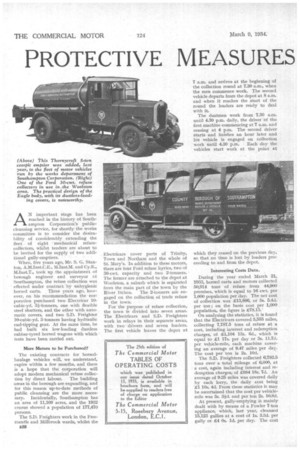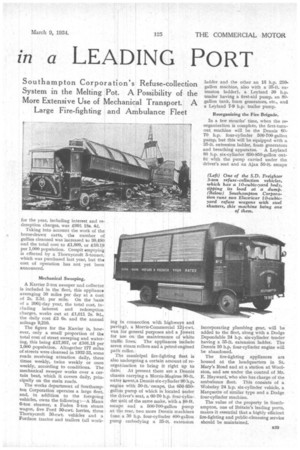PROTECTIVE MEASURES
Page 104

Page 105

If you've noticed an error in this article please click here to report it so we can fix it.
in a LEADING PORT
Southampton Corporation's Refuse-collection System in the Melting Pot. A Possibility of the More Extensive Use of Mechanical Transport. A Large Fire-fighting and Ambulance Fleet
AN important stage has been reached in the history of Southampton Corporation's publiccleansing service, for shortly the works committee is to consider the desirability of considerably extending the fleet • of eight mechanical refusecollectors, whilst tenders are about to be invited for the supply of two additional gully-emptiers.
When, five years ago, Mr. S. G. Stanton, A.M.Inst.C.E., Minst.M. and Cy.E., M.Inst.T., took up the appointment of borough engineer and surveyor at Southampton, the refuse collection was effected under contract by unhygienic horsed carts. Three years ago, however, on his recommendation the corporation purchased two Electricar 10cubic-yd. 31-tonners, one with flexible steel shutters, and the other with automatic covers, and two S.D. Freighter 10-cubic-yd. 3-tonners having hydraulic end-tipping gear. At the same time, he had built six low-loading dustless rubber-tyred horsed wagons with which tests have been carried out.
More Motors to be Purchased?
The existing contracts for horsedhaulage vehicles will, we understand, expire within a few months, and there is a hope that the corporation will adopt modern mechanical refuse collection by direct labour. The building areas in the borough are expanding, and for this reason up-to-date methods of public cleansing are the more necessary. Incidentally, Southampton has an area of 11,109 acres, and the 1932 census showed a population of 177,470 persons.
The S.D. Freighters work in the Freemantle and Millbrook wards, whilst the 338 Electricars cover parts of Trinity, Town and Northam and the whole of St. Mary's. In addition to these motors, there are four Ford refuse lorries, two of 30-cwt. capacity and two 2-tanners. The former are attached to the depot at Woolston, a suburb which is separated from the main part of the town by the
River Itchen. The 2-tonners are engaged on the collection of trade refuse in the town.
For the purpose of refuse collection, the town is divided into seven areas. The Electricars and S.D. Freighters work in relays in their separate areas, with two drivers and seven loaders. The first vehicle leaves the depot at 7 a.m. and arrives at the beginning of the collection round at 7.30 a.m., when the men commence work. The second vehicle departs from the depot at 8 a.m. and when it reaches the start of the round the loaders are ready to deal with it.
The dustmen work from 7.30 a.m. until 4.30 p.m. daily, the driver of the first machine commencing at 7 a.m. and ceasing at 4 p.m. The second driver starts and finishes an hour later and his vehicle is engaged on collection work until 4.30 p.m. Each day the vehicles start work at the point at which they ceased on the previous day, so that no time is lost by loaders proceeding to and from the depot.
Interesting Costs Data.
During the year ended March 31, 1933, horsed carts and motors collected 50,914 tons of refuse from 44,900 premises, which is equal to 16 cwt. per 1,000 population per day. The net cost of collection was 213,866, or Os. 5.4d. per ton ; on the basis cost per 1,900 population, the figure is £78.13.'
On analysing the statistics, it is found that the Electricars covered 5,555 miles, collecting 7,787.5 tons of refuse at a cost, including interest and redemption charges, of £1,104 13s. 6d., which is equal to £1 17s. per day or 3s. 11.7d. per vehicle-mile, each machine covering an average of 9.47 miles per day. The cost per ton is 2s. 10d.
The S.D. Freighters collected 6,783.5 tons over a total mileage of 6,000, at a cost, again including interest and redemption charges,of £984 18s. 7d. An average of 9.25 miles was covered daily by each lorry, the daily cost being £1 1.0s. 4d. From these statistics it may be ascertained that the cost per vehiclemile was 3s. 3.id. and per ton 2s. 10.8d.
At present, gully-emptying is mainly dealt with by means of a Fowler 7-ton appliance, which, last year, cleansed 15,123 gullies at a cost of is. 3.3d. per gully or £4 Os. 1d, per day. The cost for the year, including interest and redemption charges, was £991 18s. 4d.
Taking into account the work of the horse-drawn carts, the number of gullies cleansed was increased to 30,490 and the total cost to £1.809, or £10.19 per 1,000 population. Cesspit emptying is effected by a Thornycroft 5-tonner, which was purchased last year, but the cost of operation has not yet been announced.
Mechanical Sweeping.
A Karrier 3-ton sweeper and collector is included in the fleet, this appliance averaging 30 miles per day at a cost of 2s. 2.3d. per mile. On the basis of a 3061-day year, the total cost, including interest and redemption charges, works out at £1,011 2s. 9d., the daily cost £3 6s. and the annual mileage 9,210.
The figure for the Karrier is, however, only a small' proportion of the total cost of street sweeping and watering, this being £17,957, or £101.18 per 1,000 population. Altogether 177 miles of streets were cleansed in 1932-33, some roads receiving attention daily, three times weekly, twice weekly or once weekly, according to conditions. The mechanical sweeper works over a certain beat, which it covers daily, principally on the main roads.
The works department of Southampton Corporation operates a large fleet, and, in addition to the foregoing vehicles, owns the following :—A Mann 6-ton steamer, a Foden 5-ton steam wagon, five Ford 30-cwt. lorries, three Thomycroft 30-cwt vehicles and a Fordson tractor and trailers (all work
lag in connection with highways and paving), a Morris-Commercial 121-cwt. van for general purposes and a jowett for use on the maintenance of white traffic lines. The appliances include seven steam rollers and a petrol-engined path roller.
The municipal fire-fighting fleet is also undergoing a certain amount of reorganization to bring it right up to date. At present there are a Dennis chassis carrying a Morris-Magims 80-ft. water tower, a Dennis six-cylinder 90 h.p. engine with 50-ft. escape, the 650-850gallon pump of which is located under the driver's seat, a 60-70 h.p. four-cylinder unit of the same make, with a 50-ft, escape and a 500-700-gallon pump at the rear, two more Dennis machines (one a 30 h.p. four-cylinder 400-gallon pump embodying a 35-ft. extension ladder and the other an 18 h.p. 250gallon machine, also with a 35-ft. extension ladder), a Leyland 30 h.p. tender having a first-aid pump, an 80gallon tank, foam generators, etc., and a Leyland 7-9 h.p. trailer pump.
Reorganizing the Fire Brigade.
In a few months' time, when thereorganization is complete, the first-turnout machine will be the Dennis 6070 h.p. four-cylinder 500-700-gallon pump, but this will be equipped with a 35-ft. extension ladder, foam generators and breathing apparatus. A Leyland 80 h.p. six-cylinder 650-850-gallon outfit with the pump carried under the driver's seat and an Ajax 50-ft. escape incorporating plumbing gear, will be added to the fleet, along with a Dodge Dependable 24 h.p. six-cylinder tender having a 35-ft. extension ladder. The Dennis 30 h.p. four-cylinder engine will be abandoned.
The fire-fighting appliances are housed at the headquarters in St. Mary's Road and at a station at Woolston, and are under the control of Mr. E. Hayward, who also has charge of the ambulance fleet. This consists of a Wolseley 24 h.p. six-cylinder vehicle, a Marquette of similar type and a Dodge four-cylinder machine.
The value of the property in Southampton, one of Britain's leading ports, makes it essential that a highly efficient fire-fighting and public-cleansing service should be maintained.












































































































































































